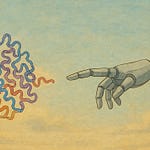Lenacapavir is a new HIV drug that blocks infections with an efficacy rate of nearly 100%, and it could completely change the fight against HIV worldwide. In episode one of Hard Drugs, Saloni and Jacob talk about the development and prospects for this new drug, as well as the history of HIV, the initial discovery of retroviruses, and how HIV was transformed from a death sentence to a manageable condition.
Hard Drugs is a new podcast from Works in Progress and Open Philanthropy about medical innovation presented by Saloni Dattani and Jacob Trefethen.
You can watch or listen on YouTube, Spotify, or Apple Podcasts.
Saloni’s Substack:
Jacob’s blog: https://blog.jacobtrefethen.com/
Books:
How to Survive a Plague — by David France (2016). [Mentioned as a history of the science and activism against the AIDS epidemic, and the protease-inhibitor breakthrough.] https://surviveaplague.com/
And the Band Played On — Randy Shilts (1987). [Mentioned as an account of the early years of AIDS.] https://us.macmillan.com/books/9780312374631/andthebandplayedon/
Drug development stories: From bench to bedside — Elsevier (2024). [Mentioned as containing a history of the development of lenacapavir] https://shop.elsevier.com/books/drug-discovery-stories/yu/978-0-443-23932-8
Retrospectives:
The development of antiretroviral therapy and its impact on the HIV-1/AIDS pandemic — Samuel Broder (2015). https://doi.org/10.1016/j.antiviral.2009.10.002
History of the discoveries of the first human retroviruses: HTLV-1 and HTLV-2 — Robert Gallo (2005). https://doi.org/10.1038/sj.onc.1208980
A Look at Long Acting Drugs — Anne de Bruyn Kops for Open Philanthropy (2025). https://bit.ly/long-acting-drugs-op
How To Save Twenty Million Lives, with Dr Mark Dybul — Statecraft (2023)
The Road to Fortovase. A History of Saquinavir, the First Human Immunodeficiency Virus Protease Inhibitor — Redshaw et al. (2000) https://link.springer.com/chapter/10.1007/978-3-642-57092-6_1
Articles:
The origin of genetic diversity in HIV-1 — Smyth et al. (2012). [Mentioned as a review about HIV’s recombination, which described it as “a primitive form of sexual reproduction”] https://www.sciencedirect.com/science/article/pii/S0168170212002122
PF74 Reinforces the HIV-1 Capsid To Impair Reverse Transcription-Induced Uncoating — Rankovic et al. (2018) https://doi.org/10.1128/JVI.00845-18
Twice-Yearly Lenacapavir for HIV Prevention in Men and Gender-Diverse Persons — Kelley et al. (2024) https://www.nejm.org/doi/full/10.1056/NEJMoa2411858
Twice-Yearly Lenacapavir or Daily F/TAF for HIV Prevention in Cisgender Women — Bekker et al. (2024) https://www.nejm.org/doi/10.1056/NEJMoa2407001
The evolution of HIV-1 and the origin of AIDS — Sharp and Hahn (2010) https://doi.org/10.1098/rstb.2010.0031
Pathogenic mechanisms of HIV disease — Moir et al. (2011) https://doi.org/10.1146/annurev-pathol-011110-130254
Estimating per-act HIV transmission risk: a systematic review — Patel et al. (2012) https://journals.lww.com/aidsonline/fulltext/2014/06190/Estimating_per_act_HIV_transmission_risk__a.14.aspx
The structural biology of HIV-1: mechanistic and therapeutic insights — Engelman and Cherepanov (2012) https://doi.org/10.1038/nrmicro2747
Challenges and opportunities in the development of complex generic long-acting injectable drug products — O’Brien et al. (2021) https://doi.org/10.1016/j.jconrel.2021.06.017
Making a “Miracle” HIV Medicine — Nahas (2025) https://press.asimov.com/articles/hiv-medicine
Highly active antiretroviral therapy transformed the lives of people with HIV — Dattani (2024) https://ourworldindata.org/data-insights/highly-active-antiretroviral-therapy-transformed-the-lives-of-people-with-hiv
Videos:
Mini-Lecture Series: HIV Capsid Inhibitors: Mechanism of Action — David Spach, National HIV Curriculum (2024)
Image credits:
Mini-Lecture Series: HIV Capsid Inhibitors: Mechanism of Action — David Spach, National HIV Curriculum (2024) [Multiple diagrams of HIV capsid and lenacapavir’s effect.]
Saloni Dattani; Our World in Data (2024) Highly active antiretroviral therapy transformed the lives of people with HIV. [Graph of decline in HIV/AIDS mortality after HAART was introduced.]
Engelman and Cherepanov (2012). The structural biology of HIV-1: mechanistic and therapeutic insights. [Diagram of HIV’s entry into the cell.]
Susan Moir, Tae-Wook Chun, Anthony S Fauci (2011). Pathogenic mechanisms of HIV disease. [Diagram of HIV replication rates over time, contrasting acute and chronic infection.]
Saloni Dattani, adapted from Patel et al. (2014). Estimating per-act HIV transmission risk: a systematic review. [Bar chart of risks of contracting HIV from different sources when unprotected.]
Thomas Splettstoesser under CC-BY. [Diagram of HIV’s internal structure.]
Twice-Yearly Lenacapavir or Daily F/TAF for HIV Prevention in Cisgender Women — Bekker et al. (2024) [Chart of lenacapavir’s efficacy.]
Our World in Data based on Joint United Nations Programme on HIV/AIDS (2024). [Chart of global HIV deaths over time.]
Acknowledgements:
Douglas Chukwu, researcher at Open Philanthropy
Sanela Rankovic, Acting Instructor at the Institute for Protein Design, University of Washington
Aria Babu, editor at Works in Progress
Adrian Bradley, on-site producer
Anna Magpie, fact-checking
Abhishaike Mahajan, cover art
Atalanta Arden-Miller, art direction
David Hackett, composer
Hard Drugs is produced by Works in Progress & Open Philanthropy.











